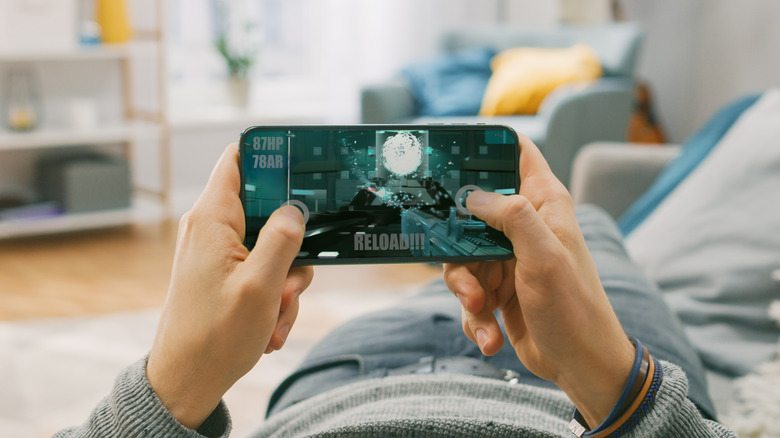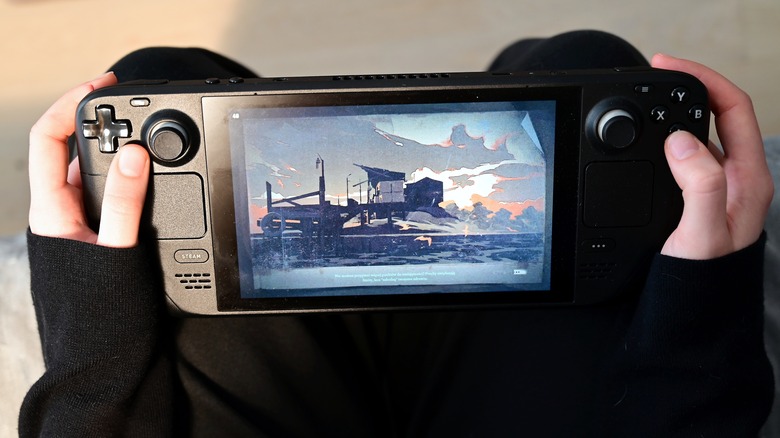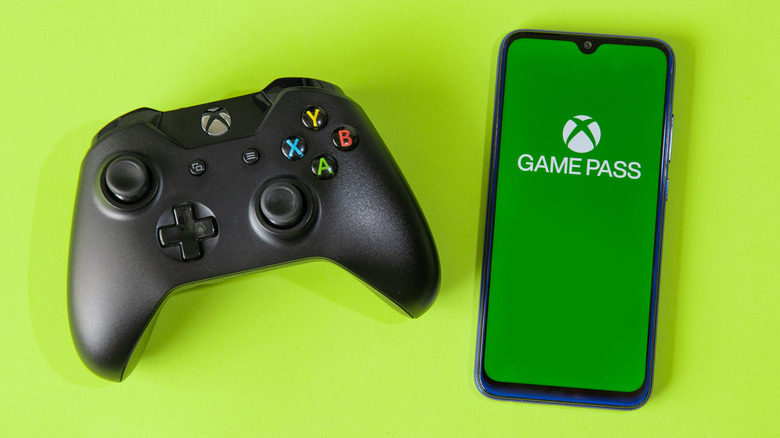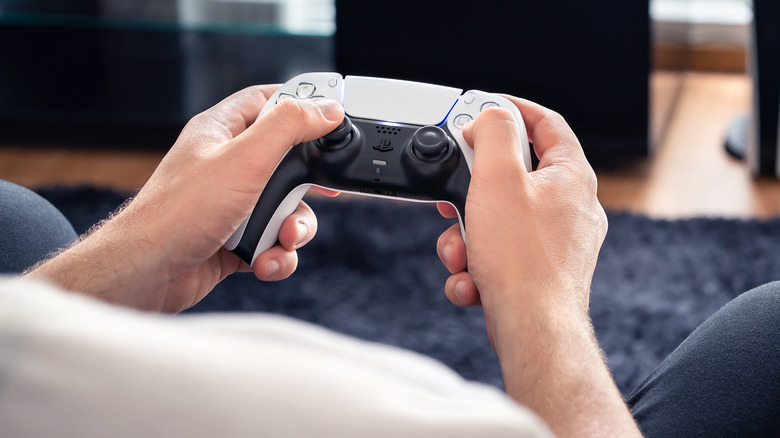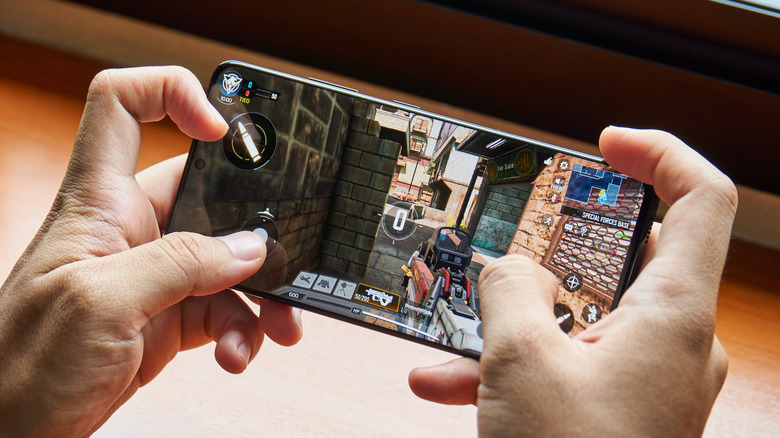How To Turn Your Old Android Phone Into A Portable Gaming Device
For Samsung, Huawei, and other tech giants in the Android arena, success has meant an almost constant need to iterate on their most popular models, to an extent that enthusiasts can find difficult to keep up with. This begs the question: what to do with old cell phones once they're replaced?
According to the BBC in August 2019, a survey commissioned by the Royal Society of Chemistry concluded that, in the U.K. alone, around 40 million "obsolete" phones, TVs, tablets, and so on are left forgotten. How can ardent gamers right this terrible technological wrong? By converting one of their old cell phones into a handheld gaming device.
Doing this is not just practical and economical, it also saves the precious battery life of a primary smartphone. There are limitations and caveats to remote gaming, but it can prove incredibly liberating too. Here are some great ways to get involved with just that, giving some once-beloved tech a new lease of life in the process.
First, think about the games you want and the gaming tech you already have
Whether you're a PC player, a console fan, or both, the way you game has probably evolved significantly in your lifetime. No longer do we need to be tethered to TV screens and the short reach of controller wires, or to our PCs. The powerful Steam Deck, pictured above, gives you access to your Steam library wherever you are, and can also be docked for big screen play a la Nintendo Switch.
Through Steam Link, users of Valve's service who don't own a Steam Deck can also play on mobile, simply using the Steam Link app and linking it up to a PC accessing the digital store. Between these three methods, a previously forgotten Android phone can serve as a powerful gaming device.
PlayStation and Xbox fans, however, need to jump through a minor hoop or two to play while away from their home system itself. They can do so, however, and right on an Android system to boot: Android is now compatible with both PS Remote Play and Xbox Game Pass cloud gaming. A PlayStation 4 or PlayStation 5 and a valid PSN account are required for the former, and the Xbox Game Pass app and a Bluetooth Xbox Wireless Controller for the latter. Both, as would be expected, further require a speedy connection (PlayStation suggests a benchmark of 15mps for best results).
Accessing Xbox Game Pass Via Android
Xbox, with the might of Microsoft behind it, already boasted a convenient link between its home consoles and PCs. The Xbox Game Pass Mobile App allows users to window shop through the tremendous range of titles available via Game Pass, learn which are coming to the service next, and download their picks to either their Xbox family system or gaming rig. It's a quick and convenient service, but another feature, which is currently in beta, makes the app all the more invaluable.
Xbox Cloud Gaming (Beta) allows fans to play on mobile devices, using a PlayStation DualShock 4 Controller as well as Xbox controllers. For mobile device users in particular, touchscreen control is available for certain titles. Though Smart TVs, iPads, and iPhones are also compatible, among other systems, Android devices (above Bluetooth 4.0 and Android 6.0) can connect too.
Xbox Game Pass Ultimate users (this is a prerequisite) need only install the Xbox Game Pass app, then use their Microsoft account from Xbox. Click Cloud, browse for a game, and then select play.
Accessing PS Remote Play Via Android
PlayStation 4 and PlayStation 5 owners, meanwhile, have an app of their own to allow for portable gaming. The PS Remote Play app, available for Android via the Google Play Store, is needed first, as is a PS5 or PS4.
There are initial steps that must be completed the very first time. To enable Remote Play functionality on a PS5, it's as easy as opening the Remote Play option in the System Settings and selecting Enable Remote Play.
To do the same on a PS4, open the Settings menu and select Enable Remote Play, this time navigating from the Remote Play Connection Settings.
With the home console primed and powered up but idle, your Android device can then be used to control it and play. To do this, open the PS Remote Play app on it (Android 8 or later is required), input your details from that same PSN account, and then choose the setting for PS4 or PS5 as appropriate. Once your console is recognized by the app, your Android device is then active and can be used to play any titles that the system has available.
Controllers And Other Caveats
Mobile gaming, the phenomenon that it has become, has its downsides. One of the primary ones, for titles that have been ported (or that are being played on a mobile device from a different system, as in these examples), is controls. If touchscreen controls aren't available for a given title, on-screen buttons are often the alternative, and this can be very awkward indeed with a title designed for a home console.
Many users of remote gaming, as such, ensure that they have a controller up to the task. Conveniently, both Xbox and PlayStation's remote play options are compatible with their system's own native controllers, through a wireless connection or USB (in the latter case). However, requirements can be a little steeper. The DualShock 4 and DualSense controllers require at least Android 10 and Android 12 respectively to be used in this way.
Alongside Remote Play for PS4 and PS5 being largely tied to the respective systems, it's also important to note that input latency, so often the scourge of gaming sessions, can be problematic with some controllers and mobile devices. It's important, then, to find a controller that works for you. The much-ballyhooed Backbone One arrived for Android in November of 2022, and enables users to snap in their mobile devices and enjoy their titles that way.
